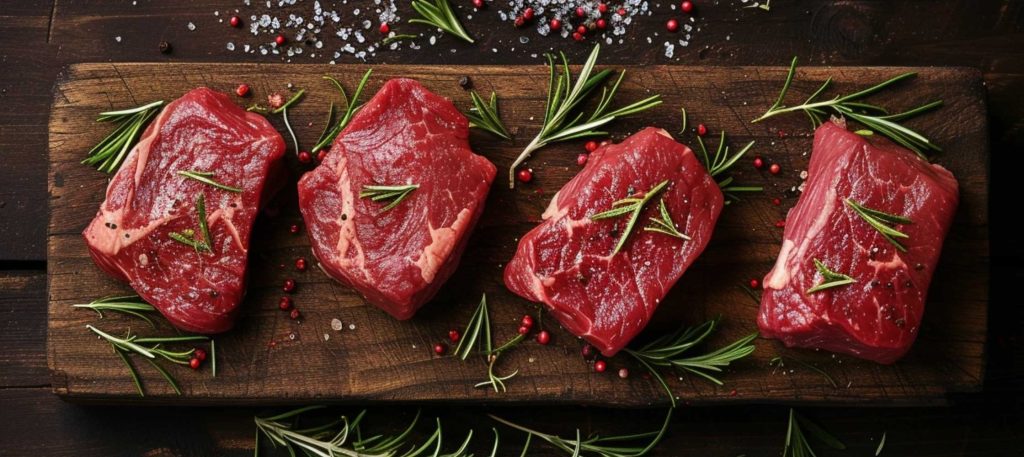|
Getting your Trinity Audio player ready...
|

Ah, the eternal culinary debate: lamb versus beef. If you’re like most folks in the US, chances are your dinner plate has seen more beef than a cowboy convention. But every so often, perhaps at a fancy dinner or that one Mediterranean restaurant everyone raves about, lamb makes a grand entrance, and you’re left wondering, “Is this the healthier choice?”
It’s a question that’s not only about taste but about our health, our planet, and yes, even our dinner conversations. After all, who hasn’t tried to one-up their foodie friend with some juicy tidbits on omega-3 fatty acids? So, let’s slice into this meaty topic, shall we? And I promise, the journey will be as engaging as choosing between a steak and lamb chops at your favorite restaurant.
Historical and Cultural Context
When it comes to meat consumption, Americans have a beefy preference. The land of the free and the home of the brave is also the kingdom of beef lovers, with consumption rates that dwarf those of lamb. But why is this the case? Let’s take a culinary dive into the past and around the world to understand our meaty preferences better.
In many parts of the world, lamb is the red meat of choice. Countries like Australia, New Zealand, and many regions in the Mediterranean have long embraced lamb for its flavor, versatility, and nutritional benefits. Yet, in the United States, lamb is often seen as a guest star on the menu, rather than the leading role it plays elsewhere. The average American eats less than a pound of lamb yearly, a mere nibble compared to their beef consumption.
But why the disparity? Much of it boils down to tradition, availability, and yes, a bit of historical snobbery. Lamb was once considered a luxury in the US, a special-occasion meat that didn’t quite fit into the everyday meal plan. Beef, on the other hand, rode in on the coattails of the booming cattle industry, becoming as American as apple pie.
Yet, as our culinary horizons expand, lamb is gaining ground. Its unique flavor profile and health benefits are making it a more common sight at the dinner table. Plus, let’s be honest, telling your friends you made a lamb tagine sounds infinitely more impressive than saying you grilled up some burgers (no offense to burger aficionados).
Nutritional Profiles of Lamb and Beef
As we meander from the pastures of history into the realm of nutrition, the lamb versus beef debate takes a turn towards the analytical. Let’s don our lab coats and look at the cold, hard facts, shall we?
Nutritionally speaking, both lamb and beef pack a punch in the protein department, making them excellent choices for muscle maintenance and overall health. However, the devil, as they say, is in the details—or in this case, the fats and vitamins.
- Omega-3 Fatty Acids: Lamb strides ahead with its omega-3 content, those heart-healthy fats we all need more of. While both meats offer these essential nutrients, lamb tends to have a higher omega-3 count due to its grass-fed upbringing.
- Vitamins and Minerals: Lamb and beef are both rich in vitamins B12, zinc, and iron, crucial for energy levels, immune function, and more. Yet, lamb often boasts more selenium, while beef might edge ahead with its zinc content.
It’s fascinating to note how the diet of the animal (grass versus grain-fed) can influence the nutritional profile of the meat we eat. Grass-fed varieties of both meats tend to have healthier fat profiles and more antioxidants, underlining the importance of choosing your cuts wisely.

Health Benefits and Considerations
Diving into the health implications of our carnivorous choices, it’s clear that both lamb and beef have their merits and drawbacks. Here, balance and moderation are your best dining companions.
- Heart Health: Thanks to its omega-3s and conjugated linoleic acid (CLA), lamb can be considered a heartier choice—pun intended. These nutrients are linked to reduced heart disease risk and other health benefits.
- Saturated Fat and Cholesterol: It’s impossible to talk about red meat without addressing the elephant in the room—saturated fat and cholesterol. Yes, both lamb and beef are high in these, but choosing leaner cuts and trimming visible fat can help manage these concerns.
Remember, the way we prepare our meats can also make a difference. Grilling, broiling, and baking are healthier options that retain the meats’ nutritional integrity without adding extra fat.
Environmental and Ethical Considerations
Now, let’s step outside the kitchen for a moment and consider the broader impact of our dietary choices. The production of lamb and beef has significant environmental footprints, from water usage to greenhouse gas emissions.
Lamb, while less commonly consumed in the US, often comes from more extensive, less intensive farming practices. This can mean a smaller environmental impact per animal, but the overall picture is complex and varies by region and farming practices.
Ethically, the treatment of animals in the food production chain is a growing concern for many consumers. Here, smaller, family-run farms that prioritize animal welfare might offer more ethically palatable choices, whether you’re buying lamb or beef.
Cooking and Taste Preferences
Back in the realm of taste and culinary delights, the debate between lamb and beef is as much about flavor as it is about nutrition and ethics. Each meat brings its unique taste profile and cooking challenges to the table.
- Flavor: Lamb is known for its rich, slightly gamey flavor, a distinctive taste that sets it apart from the more mild-mannered beef. This can be a delight or a deterrent, depending on your palate.
- Culinary Uses: Beef’s versatility is well-documented, from burgers to steaks to slow-cooked roasts. Lamb, while perhaps less common in everyday American cooking, shines in a variety of dishes, from Mediterranean stews to grilled chops and beyond.
In the kitchen, both meats offer a canvas for culinary creativity. Whether you’re searing a steak to perfection or slow-cooking a lamb shoulder, the key is to respect the meat’s quality and flavor, letting its natural goodness shine through.
Conclusion
As we wrap up our foray into the lamb versus beef debate, it’s clear that there’s no one-size-fits-all answer. Nutritionally, environmentally, and culinarily, both meats have their virtues and vices. The best choice? It’s the one that aligns with your health goals, ethical beliefs, and taste buds.
So, the next time you’re at the butcher or deciding on dinner, remember that the best dish is one made thoughtfully, balancing the scales of nutrition, sustainability, and flavor. Whether you lean towards lamb or beef (or a little of both), the key is to enjoy each bite, knowing you’ve made a choice that’s right for you and the planet. Bon appétit!
- Debunking Myths About Storage Body Fat - May 2, 2024
- Is Fiji Water Good for You – Health and Environmental Guide - April 22, 2024
- Is Sparkling Ice Good for You? Health Insights Revealed - April 22, 2024
